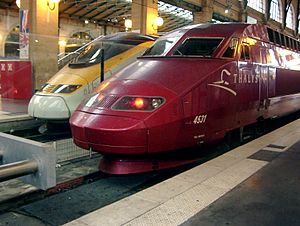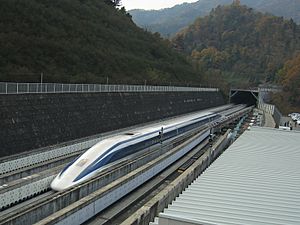High-speed rail facts for kids
High-speed rail (often called HSR) is a special type of rail transport. It uses trains that travel much faster than regular trains. These trains run on special tracks and are part of a connected system.
There isn't one rule for what counts as "high-speed" everywhere. But generally, new lines built for speeds over 250 km/h (155 mph) are called high-speed. Also, older lines that have been improved to handle speeds over 200 km/h (124 mph) are often included.
The very first high-speed rail system was the Tōkaidō Shinkansen in Honshū, Japan. It started running in 1964. Because of its sleek, pointed front, it became known as the bullet train.
Other countries soon followed Japan's lead. France and Germany were among the first in Europe. Later, Spain and Italy also built their own systems. Today, Europe has a huge network of high-speed lines, connecting many countries.
In the 21st century, China has become a leader in high-speed rail. As of 2023, China's network makes up more than two-thirds of all high-speed rail lines in the world!
Most high-speed trains use standard tracks that are continuously welded. These tracks are usually built on their own path, away from roads or other obstacles. This means they often have gentle curves and slopes. Some countries, like Russia and Uzbekistan, use wider tracks for their high-speed lines. However, countries like Japan, Spain, and India, which have different track sizes for their older railways, often choose to build their new high-speed lines using standard tracks.
High-speed rail is the fastest way to travel on land. However, building these lines can be expensive. This is because they need large, gentle curves and special tracks. So, it's not always cheaper than regular trains.
Contents
Why are High-Speed Trains Great?
High-speed trains offer many benefits for travelers:
Faster Total Travel Time
- Even though planes fly faster, the total time to get to your destination can be longer with air travel. This is because you have to travel to airports, check in, go through security, and wait to board. High-speed trains often save you time overall.
Closer to City Centers
- Train stations are usually right in the middle of cities. Airports, on the other hand, are often far outside the city. This makes trains more convenient for shorter and medium-length trips.
Better in Bad Weather
- Trains are less affected by weather than planes. A well-built train system can usually handle heavy snow or fog. Flights, however, are often canceled or delayed even in less severe weather.
More Comfortable Travel
- High-speed trains offer more comfort. Passengers can move around freely during the journey. Train seats can also be bigger and have more legroom than airplane seats. This is because trains don't have the same weight limits as planes.
- Modern tracks also reduce shaking, making the ride smoother. Planes can still have turbulence when the wind is strong.
Fewer Delays
- On busy routes, trains are less likely to be delayed due to crowded airports or airspace. If a train is a few minutes late, it doesn't have to wait for a new "slot" like a plane does.
- Some airlines even use high-speed rail instead of short flights to connect passengers.
No De-icing Needed
- Planes often need to be de-iced in cold weather, which takes a lot of time and money. High-speed trains don't need this process.
Good for Hot Weather
- In very hot weather, planes sometimes have to cancel flights or take off at night. This is because heat can affect how well planes can fly. High-speed rail can help by offering another way to travel during hot times.
Less Noise and Pollution
- High-speed trains often run on electricity, which can come from clean energy sources. Electric trains produce no local pollution in cities.
- Airports, however, can cause a lot of pollution and noise for people living nearby.
Multiple Stops are Easy
- Planes spend a lot of time loading and unloading. Trains, however, can stop at several stations for just a few minutes. This makes it easier to serve many cities along a route.
Energy Efficient
- High-speed trains use less fuel per passenger than planes. Also, since they run on electricity, their power can come from many different sources, not just kerosene.
Challenges of High-Speed Rail
While high-speed rail has many benefits, there are also some challenges:
Land Needs
- Building new high-speed lines often requires buying a lot of land. This can sometimes lead to legal issues and delays.
Ground Issues
- High-speed rail can be affected by the ground sinking, which can be very expensive to fix.
Difficult Terrain
- Crossing mountains or large bodies of water means building costly tunnels and bridges. This makes construction more difficult and expensive.
High Costs
- High-speed rail is expensive to build because it needs special tracks, advanced technology, and many safety systems.
Fixed Routes
- Once built, the tracks are fixed. This means the train services can't easily change if market conditions change. However, for passengers, this can be a good thing, as train routes are less likely to be canceled than flights.
Indirect Routes
- Because it's so expensive, it's not possible to build a direct line between every major city. This means some journeys might include stops at other stations, making the trip longer.
Cooperation Needed
- Building high-speed rail across different regions or countries requires governments and local areas to work together.
Electricity Grid
- All high-speed trains are electric. This means they need a large electricity network to power their overhead lines.
Environmental Impact
High-speed rail usually uses electric power. This means its energy can come from far away power plants or from renewable energy sources. Using electric power in high-speed trains can help reduce air pollution. This is a big advantage over air travel, which mostly uses fossil fuels and is a major source of pollution.
Studies near busy airports, like LAX, have shown that pollution from planes can be much higher than pollution from cars, even on busy highways.
Trees and Tracks
Airports often require trees to be cut down because they can block pilots' views. For example, about 3,000 trees were cut near Seattle–Tacoma International Airport.
On the other hand, trees next to train lines can sometimes become a danger during winter storms. Falling branches can damage tracks or overhead lines.
Safety Record
High-speed rail is very safe because its path is predictable. High-speed rail systems reduce crashes with cars or people by building tracks that are separate from roads and don't have level crossings.
So far, there have only been two deadly accidents involving a high-speed train on high-speed tracks with paying passengers. These were the 1998 Eschede train disaster and the 2011 Wenzhou train collision. In the Wenzhou accident, the train's speed was not the cause.
Images for kids
-
The Tōkaidō Shinkansen high-speed line in Japan, with Mount Fuji in the background. This line was the world's first high-speed rail.
-
A high-speed line on a viaduct, with a British Rail Class 373 Eurostar train crossing it.
-
The V150 train, a modified TGV, which holds the conventional world speed record of 574.8 km/h (357.2 mph).
See also
 In Spanish: Alta velocidad ferroviaria para niños
In Spanish: Alta velocidad ferroviaria para niños


































